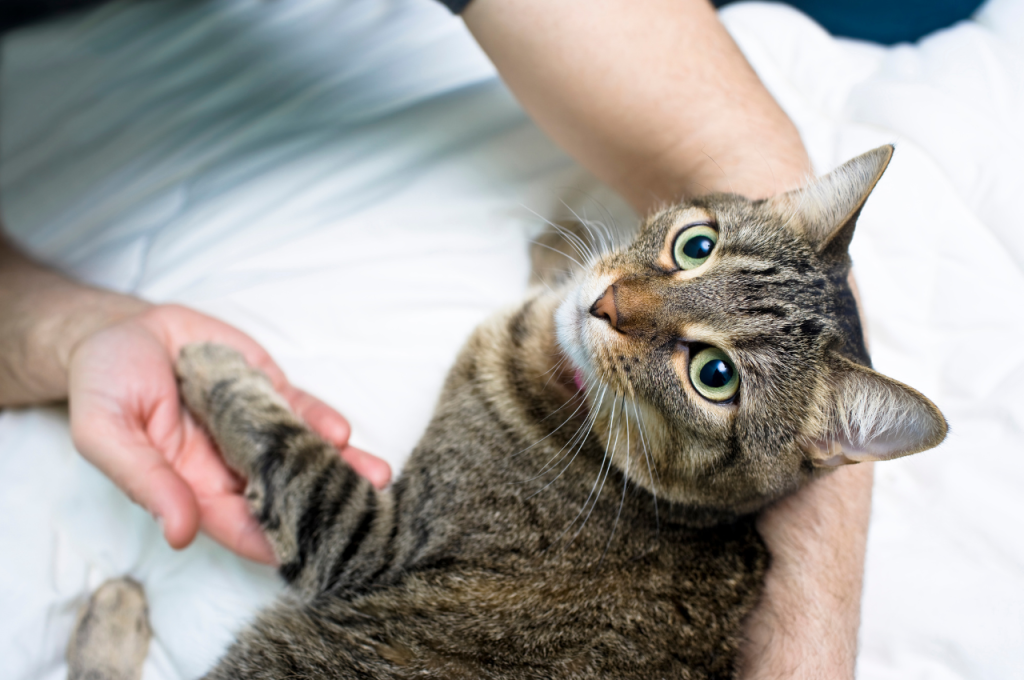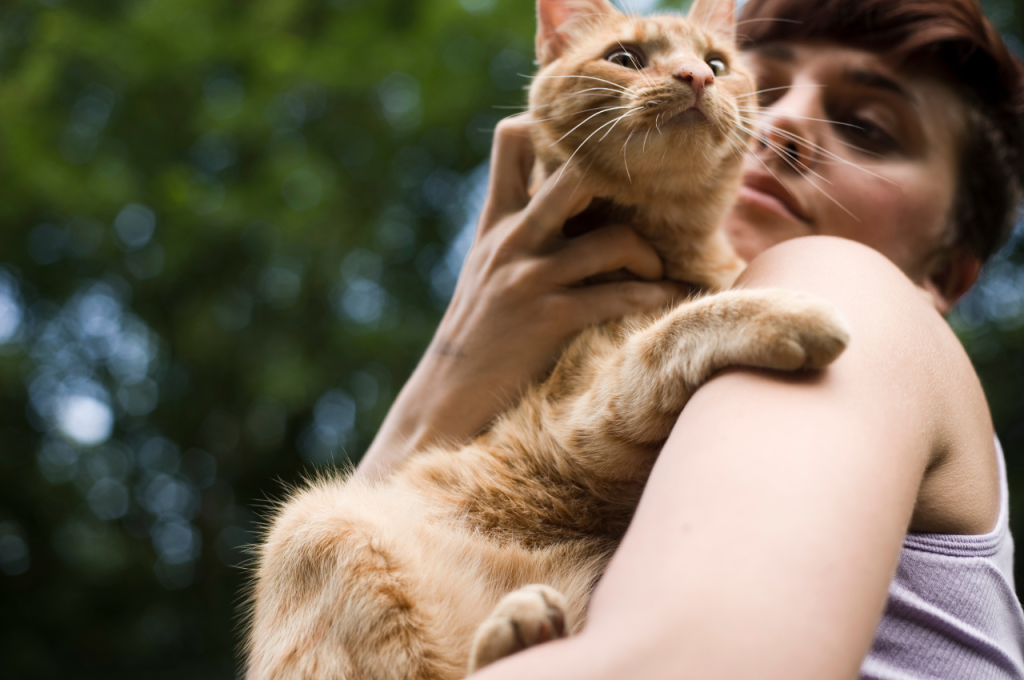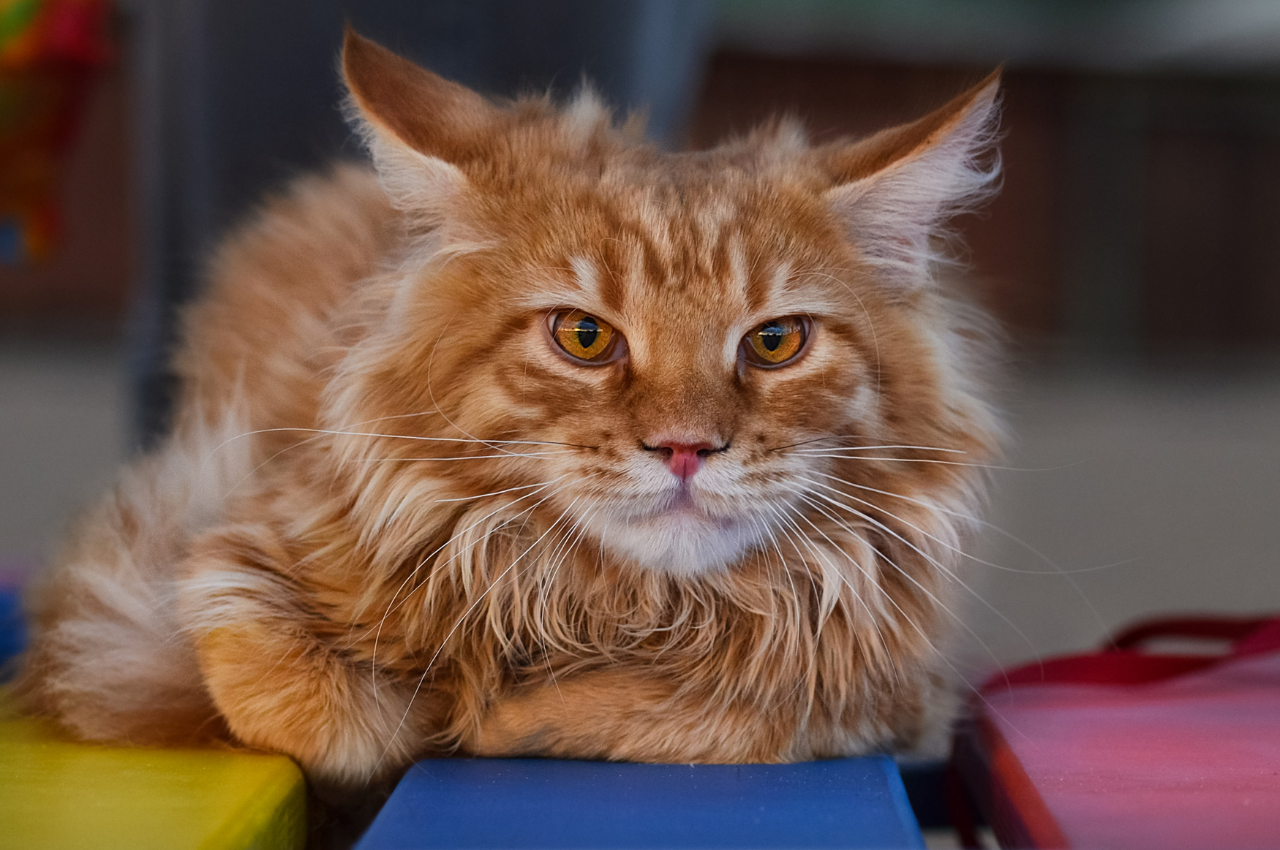If your cat is protective of you, it may exhibit behaviors such as following you around or becoming territorial. It might also display signs of aggression toward perceived threats.
When you have a close bond with your cat, you may notice that it becomes protective of you. Cats that are protective may show behaviors such as staying close to you, following you from room to room, or even acting aggressively towards strangers or other animals that they perceive as a threat to you. Understanding these signs can help you recognize and appreciate the bond you share with your feline friend. In this blog, we will explore the various ways in which cats demonstrate their protective instincts and how you can foster a strong and healthy relationship with your loyal companion.
Introduction to Feline Loyalty
Feline loyalty is a fascinating topic for cat owners. Have you ever wondered if your cat is protective of you? There are many signs that indicate your cat’s protective behavior towards you.

The Bond Between Cats and Humans
Cats are known for their independent nature and aloof behavior, which is why many people assume that they are not capable of forming strong bonds with humans. However, this is far from the truth. Cats can be incredibly loyal and protective of their owners, just like dogs. In fact, some cats may even become more attached to their human companions than they are to other cats. The bond between cats and humans is a unique and special one, based on trust, respect, and mutual affection.
Misconceptions About Cat Behavior
Unfortunately, there are many misconceptions about cat behavior that can lead people to underestimate their pets’ loyalty and protective instincts. For example, some people believe that cats are cold and indifferent creatures that only tolerate humans for their own benefit. Others think that cats are always aloof and unresponsive and that they do not care about their owners’ well-being. These stereotypes are not only inaccurate but also unfair to cats, who are capable of showing love and loyalty in their own unique ways.
How to Tell If Your Cat is Protective of You
There are several signs to look out for. For example, if your cat follows you around the house and tries to keep you in sight at all times, it may be trying to protect you from potential dangers. Similarly, if your cat becomes agitated or aggressive when strangers or other animals approach you, it may be trying to defend you. Other signs of feline protectiveness include purring, rubbing against you, and bringing you gifts such as dead mice or birds.
In conclusion, cats can be just as loyal and protective of their owners as dogs, and it is important to recognize and appreciate this aspect of their behavior. By understanding the bond between cats and humans and learning to recognize the signs of feline protectiveness, you can deepen your relationship with your furry companion and enjoy a lifetime of love and companionship.
Physical Signs of Protection
Physical signs of protection include your cat staying close to you, hissing or growling at perceived threats, and positioning themselves between you and potential danger. These behaviors indicate your cat’s protective instincts.
Body Language Cues
When a cat is protective of you, their body language may reveal it. Here are some body language cues to look out for:
- Standing tall and puffing up their fur to appear larger
- Direct eye contact with dilated pupils
- Positioning themselves between you and perceived threats
Vocalizations and Their Meanings
Cats communicate their protective instincts through vocalizations and their meanings. Here’s what to listen for:
- Hissing: Indicates fear or aggression, often directed at perceived threats
- Growling: Signals readiness to defend against potential danger
- Chirping or chattering: Shows alertness and a desire to protect you from nearby prey
Behavioral Indicators
Understanding your cat’s behavior is essential for building a strong bond with them. One intriguing aspect of feline behavior is their potential for protectiveness towards their human companions. Cats can display various behavioral indicators that reveal their protective nature. By recognizing these signs, you can gain insight into how your furry friend feels about you and ensure their well-being. In this article, we will explore some key behavioral indicators that suggest your cat is protective of you.
Following You Around
One of the most common behavioral indicators of a protective cat is their tendency to follow you around. Cats are naturally curious creatures, but when they consistently stick by your side, it goes beyond mere curiosity. Whether you are moving from one room to another or going outside, your protective cat will be right there, keeping a watchful eye on you. This behavior signifies that they see you as their cherished companion and want to ensure your safety.
Intervening in Uncomfortable Situations
Another clear sign of a protective cat is their inclination to intervene in uncomfortable situations. If they perceive any threat or perceive you as being in distress, they may step in to protect you. This can manifest in various ways, such as hissing, growling, or even physically positioning themselves between you and the perceived threat. By doing so, they are asserting their protective nature and communicating their willingness to defend you.
Additionally, a protective cat may exhibit changes in their body language during these situations. They may puff up their fur, arching their back, or raise their tail as a way to appear larger and more intimidating to the potential threat. These defensive gestures are indicative of their commitment to keeping you safe.
It is important to note that while some cats may display protective behavior, others may be more reserved or independent. Each cat has its own unique personality, and their level of protectiveness may vary. Nonetheless, by recognizing these behavioral indicators, you can better understand the bond you share with your feline friends and appreciate the love and care they have for you.
Territorial Behaviors
Detecting if your cat is protective involves observing territorial behaviors like marking territory, body language, and vocalizations. Cats may display protective behavior by following you around, acting aloof towards strangers, or even hissing to show their loyalty and defense.

Cats are known for their independent nature, but they can also exhibit protective behaviors towards their owners. One way to understand if your cat is protective of you is by observing their territorial behaviors. Cats have a strong sense of territory, and they often display certain actions to mark their space and protect it. Let’s explore some of these behaviors in more detail.
Marking Their Territory Around You
Cats have scent glands located on various parts of their bodies, including their paws, cheeks, and tail. One common territorial behavior is rubbing their scent onto objects and people they consider part of their territory. If your cat frequently rubs against your legs, furniture, or other belongings, they may be marking you as part of their territory. This behavior is a sign of affection and protection, as they are claiming you as their own.
Additionally, cats may also use urine marking to establish their territory. While this behavior is more common in unneutered male cats, both males and females can exhibit this behavior. If your cat is frequently urinating in specific areas around your home or near entrances and windows, it could be a sign that they are protecting their territory and ensuring any intruders are aware of their presence.
Reacting to New People or Animals
Another way to determine if your cat is protective of you is by observing their reactions to new people or animals entering your home. Cats that are protective of their owners may display defensive behaviors when unfamiliar individuals or animals are present. These behaviors can include hissing, growling, or even swatting at the intruders. While it’s important to socialize your cat and introduce them to new experiences, their protective instincts may kick in when they feel their territory or you are threatened.
It’s essential to provide a safe and secure environment for your cat to feel protected. If your cat is showing signs of aggression towards visitors, it may be helpful to gradually introduce them to new people and animals in a controlled manner. This can help your cat feel more comfortable and reduce their protective behaviors over time.
The Role of Socialization
Cats show their protective nature through various behaviors like following you around, staying close when you’re upset, or hissing at strangers. They may also display signs of territoriality, like marking their territory or growling at other animals. These actions indicate that your cat sees you as their family and wants to keep you safe.
Impact of Early Socialization
When it comes to determining whether your cat is protective of you, it’s essential to consider their socialization history. Early socialization plays a significant role in shaping a cat’s behavior. Kittens that are exposed to humans and other animals during their formative weeks are more likely to grow up to be sociable and affectionate cats. If your cat was not socialized correctly during their early weeks, they may exhibit fear and aggression towards strangers, making it challenging for them to form a protective bond with their owners. However, it’s never too late to socialize with a cat, and with patience and persistence, you can help your cat become more trusting and protective of you.
Building Trust with Your Cat
Building trust with your cat is a crucial step in developing a protective bond. The best way to build trust with your cat is to spend time with them, providing them with affection, food, and playtime. By creating a routine that your cat can depend on, they’ll feel more secure in their environment, and this can help them become more protective of you. It’s also essential to recognize your cat’s body language and vocal cues, as this can help you better understand their behavior. For instance, if your cat is hiding or hissing when they encounter strangers, it’s a sign that they feel threatened and need protection. By understanding your cat’s behavior and building a positive relationship with them, you can help them become more protective of you and their home.
Misinterpretations of Protective Behavior
When it comes to understanding your cat’s protective behavior, it’s crucial to be aware of potential misinterpretations. Misunderstanding your cat’s actions can lead to unnecessary stress and miscommunication. By recognizing and distinguishing between protective behavior and aggression, you can better understand your feline companion.
Aggression Vs. Protection
- Growling and hissing
- Swatting or scratching without provocation
- Puffed-up fur and a tense body posture
- Staying close to you when feeling threatened
- Alertness and vigilance when strangers are present
- Gentle nudging or rubbing to reassure you
Understanding Your Cat’s Unique Personality
Each cat has a distinctive personality, and their protective behavior may vary based on their individual traits. Some cats may be more vocal or assertive in guarding their owners, while others may demonstrate protective tendencies in subtle ways. Observing your cat’s behavior in different situations can help you understand how they express their protective instincts.
Fostering a Protective Relationship
Cats can develop a protective instinct towards their owners, demonstrating their loyalty and affection in various ways. Fostering a protective relationship with your feline companion involves creating a safe environment, and providing positive reinforcement and training.

Creating a Safe Environment
Creating a safe environment for your cat is essential for fostering a protective relationship. Ensure they have a secure and comfortable space within your home. This could include providing cozy hiding spots and perches, as well as ensuring there are no potential hazards in their environment.
Positive Reinforcement and Training
Positive reinforcement and training are crucial in developing a protective bond with your cat. Use treats and praise to reward protective behavior, such as standing guard or showing signs of alertness. Additionally, engage in interactive play and bonding activities to strengthen your relationship and build trust.
Conclusion
Recognizing signs of your cat’s protectiveness is crucial for a strong bond. By observing behavior cues like body language and vocalization, you can understand your cat’s feelings. Building trust and providing a safe environment will strengthen your relationship with your protective feline companion.
